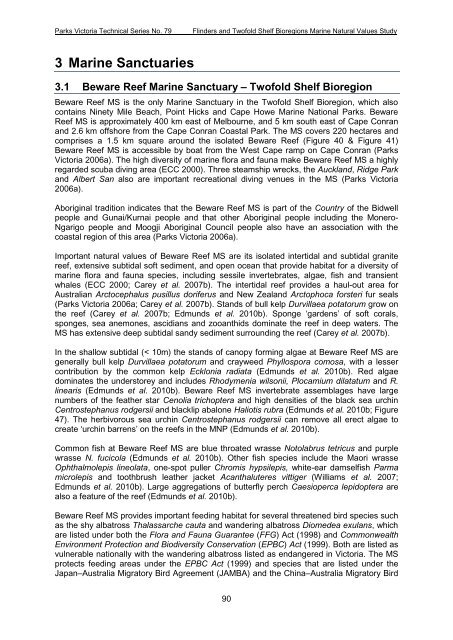parks victoria technical series marine natural values study vol 2 ...
parks victoria technical series marine natural values study vol 2 ...
parks victoria technical series marine natural values study vol 2 ...
You also want an ePaper? Increase the reach of your titles
YUMPU automatically turns print PDFs into web optimized ePapers that Google loves.
Parks Victoria Technical Series No. 79<br />
Flinders and Twofold Shelf Bioregions Marine Natural Values Study<br />
3 Marine Sanctuaries<br />
3.1 Beware Reef Marine Sanctuary – Twofold Shelf Bioregion<br />
Beware Reef MS is the only Marine Sanctuary in the Twofold Shelf Bioregion, which also<br />
contains Ninety Mile Beach, Point Hicks and Cape Howe Marine National Parks. Beware<br />
Reef MS is approximately 400 km east of Melbourne, and 5 km south east of Cape Conran<br />
and 2.6 km offshore from the Cape Conran Coastal Park. The MS covers 220 hectares and<br />
comprises a 1.5 km square around the isolated Beware Reef (Figure 40 & Figure 41)<br />
Beware Reef MS is accessible by boat from the West Cape ramp on Cape Conran (Parks<br />
Victoria 2006a). The high diversity of <strong>marine</strong> flora and fauna make Beware Reef MS a highly<br />
regarded scuba diving area (ECC 2000). Three steamship wrecks, the Auckland, Ridge Park<br />
and Albert San also are important recreational diving venues in the MS (Parks Victoria<br />
2006a).<br />
Aboriginal tradition indicates that the Beware Reef MS is part of the Country of the Bidwell<br />
people and Gunai/Kurnai people and that other Aboriginal people including the Monero-<br />
Ngarigo people and Moogji Aboriginal Council people also have an association with the<br />
coastal region of this area (Parks Victoria 2006a).<br />
Important <strong>natural</strong> <strong>values</strong> of Beware Reef MS are its isolated intertidal and subtidal granite<br />
reef, extensive subtidal soft sediment, and open ocean that provide habitat for a diversity of<br />
<strong>marine</strong> flora and fauna species, including sessile invertebrates, algae, fish and transient<br />
whales (ECC 2000; Carey et al. 2007b). The intertidal reef provides a haul-out area for<br />
Australian Arctocephalus pusillus doriferus and New Zealand Arctophoca forsteri fur seals<br />
(Parks Victoria 2006a; Carey et al. 2007b). Stands of bull kelp Durvillaea potatorum grow on<br />
the reef (Carey et al. 2007b; Edmunds et al. 2010b). Sponge ‘gardens’ of soft corals,<br />
sponges, sea anemones, ascidians and zooanthids dominate the reef in deep waters. The<br />
MS has extensive deep subtidal sandy sediment surrounding the reef (Carey et al. 2007b).<br />
In the shallow subtidal (< 10m) the stands of canopy forming algae at Beware Reef MS are<br />
generally bull kelp Durvillaea potatorum and crayweed Phyllospora comosa, with a lesser<br />
contribution by the common kelp Ecklonia radiata (Edmunds et al. 2010b). Red algae<br />
dominates the understorey and includes Rhodymenia wilsonii, Plocamium dilatatum and R.<br />
linearis (Edmunds et al. 2010b). Beware Reef MS invertebrate assemblages have large<br />
numbers of the feather star Cenolia trichoptera and high densities of the black sea urchin<br />
Centrostephanus rodgersii and blacklip abalone Haliotis rubra (Edmunds et al. 2010b; Figure<br />
47). The herbivorous sea urchin Centrostephanus rodgersii can remove all erect algae to<br />
create ‘urchin barrens’ on the reefs in the MNP (Edmunds et al. 2010b).<br />
Common fish at Beware Reef MS are blue throated wrasse Notolabrus tetricus and purple<br />
wrasse N. fucicola (Edmunds et al. 2010b). Other fish species include the Maori wrasse<br />
Ophthalmolepis lineolata, one-spot puller Chromis hypsilepis, white-ear damselfish Parma<br />
microlepis and toothbrush leather jacket Acanthaluteres vittiger (Williams et al. 2007;<br />
Edmunds et al. 2010b). Large aggregations of butterfly perch Caesioperca lepidoptera are<br />
also a feature of the reef (Edmunds et al. 2010b).<br />
Beware Reef MS provides important feeding habitat for several threatened bird species such<br />
as the shy albatross Thalassarche cauta and wandering albatross Diomedea exulans, which<br />
are listed under both the Flora and Fauna Guarantee (FFG) Act (1998) and Commonwealth<br />
Environment Protection and Biodiversity Conservation (EPBC) Act (1999). Both are listed as<br />
vulnerable nationally with the wandering albatross listed as endangered in Victoria. The MS<br />
protects feeding areas under the EPBC Act (1999) and species that are listed under the<br />
Japan–Australia Migratory Bird Agreement (JAMBA) and the China–Australia Migratory Bird<br />
90

















